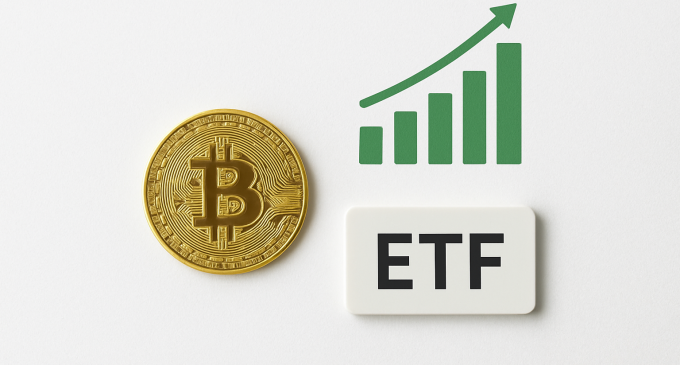
Introduction
In the weeks leading up to Bitcoin’s anticipated 2025 halving, the cryptocurrency market has witnessed a significant surge in institutional interest, driven primarily by unprecedented inflows into Bitcoin Exchange-Traded Funds (ETFs). This renewed wave of activity suggests more than just speculative movement—it reflects a broader market conviction that the upcoming halving will trigger a long-term bullish cycle for Bitcoin and the broader crypto sector.
Over $1.2 billion in new capital has entered Bitcoin ETFs in just one week, setting a record for 2025 so far. Leading investment firms like BlackRock and Fidelity are dominating the ETF space, reinforcing Bitcoin’s growing status as a legitimate, long-term investment vehicle for both institutional and retail investors.
The Rise Of Bitcoin ETFs: A New Era For Crypto Investment
The approval of spot Bitcoin ETFs in late 2024 marked a pivotal turning point in cryptocurrency adoption. These ETFs provide investors with direct exposure to Bitcoin without the complexities of private key management, storage, or self-custody. The regulatory green light for spot ETFs gave traditional investors a low-barrier, compliant entry into the crypto markets.
In 2025, Bitcoin ETFs have matured significantly. Products offered by asset management giants like BlackRock, Fidelity, Grayscale, and ARK Invest now collectively manage tens of billions in assets under management (AUM). These ETFs track the real-time price of Bitcoin while being traded like regular stocks on public exchanges, thus bridging the gap between crypto-native assets and traditional financial products.
According to CoinDesk, in the first week of June 2025 alone, Bitcoin ETFs saw inflows totaling $1.2 billion, with BlackRock’s iShares Bitcoin Trust and Fidelity’s Wise Origin Bitcoin Fund leading the charge. This surge comes at a time when Bitcoin’s price is gradually climbing after a period of consolidation, signaling market expectations of renewed upward momentum.
Institutional Inflows And Market Sentiment
Institutional money continues to flow into Bitcoin with a level of confidence not seen since the 2021 bull run. What’s different in 2025 is the sophistication and scale of these investments. Large institutions are not just speculating—they are allocating capital based on structured macro strategies that factor in inflation, interest rate trends, and fiat currency performance.
Bitcoin ETFs have become the primary vehicle for these investments. These products offer regulatory oversight, liquidity, and operational efficiency, enabling pension funds, endowments, and hedge funds to include Bitcoin in their portfolios without violating fiduciary mandates.
A recent analysis by CryptoNews revealed that BlackRock’s ETF alone accounted for nearly 35% of all Bitcoin ETF inflows in the past 30 days. This is significant not only due to the sheer scale but also because it reflects a shift in how traditional asset managers perceive digital assets—as a long-term hedge and diversification tool rather than a volatile gamble.
The investor optimism is being driven by several key factors:
Expectations of reduced supply due to the upcoming halving.
A favorable regulatory climate for digital assets.
Increased demand for alternative investments amidst global economic uncertainty.
Improved security and transparency in crypto custody and trading.
The 2025 Halving: Historical Perspective And Market Projections
Bitcoin’s halving is a built-in protocol event that occurs every 210,000 blocks, approximately every four years. It cuts the block reward that miners receive in half, thereby reducing the rate at which new Bitcoins are generated. Historically, halvings have acted as catalysts for significant price rallies.
Past Halving Cycles
2012 Halving: Bitcoin price rose from $12 to over $1,000 within a year.
2016 Halving: BTC moved from $650 to $20,000 by late 2017.
2020 Halving: The most notable yet, taking BTC from $9,000 to an all-time high of $69,000 in late 2021.
Each cycle follows a similar psychological and supply-driven trajectory. Initially, there is market hesitation, followed by accumulation, and then exponential growth as reduced supply meets sustained or growing demand.
2025 Halving Outlook
The upcoming halving, expected in Q4 2025, will reduce the block reward from 3.125 BTC to 1.5625 BTC. Analysts suggest that the economic impact could be even more pronounced this time due to:
- A larger base of global investors.
- Institutional infrastructure already in place.
- The presence of ETF products drives continuous demand.
- Broader adoption of Bitcoin in emerging economies and corporate treasuries.
Cointelegraph’s June 6 article notes that ETF flows are aligning closely with pre-halving sentiment indicators from previous cycles, which typically precede long-term uptrends.
ETF Flows As A Leading Indicator Of Price Action
The correlation between ETF inflows and Bitcoin price action has become more evident over time. Unlike speculative retail trading, ETF-driven capital tends to move in larger volumes and is often based on macroeconomic analysis rather than short-term volatility.
Strategic Accumulation
Data shows that the majority of Bitcoin ETF investors are adopting a long-term holding strategy, often referred to as “hodling.” These investors are not easily shaken by daily price swings. Instead, they buy in anticipation of fundamental shifts, such as halvings or central bank monetary policy changes.
This accumulation phase appears to be gaining traction, with CoinDesk reporting that nearly 70% of recent ETF-based BTC purchases are not being sold or moved, suggesting that they are being held in long-term cold storage by custodians like Coinbase Custody or Fidelity Digital Assets.
BlackRock And Fidelity: Titans Leading The Bitcoin ETF Race
The competition among asset management firms has intensified in 2025, with BlackRock and Fidelity dominating the Bitcoin ETF market.
BlackRock’s iShares Bitcoin Trust: Currently holds over 210,000 BTC, equivalent to nearly $15 billion in assets. Their fund is integrated with major brokerages and retirement plans.
Fidelity’s Wise Origin Bitcoin Fund: Slightly behind, with a robust marketing push targeting millennial and Gen Z investors through digital banking channels.
Both companies have played a key role in legitimizing Bitcoin for traditional investors. Their involvement has also helped reduce volatility, as their buying patterns are more stable and strategic compared to retail flows.
Regulatory Clarity Fuels Investor Confidence
Another contributing factor to the bullish sentiment is the relative regulatory clarity that has emerged in 2025. The U.S. Securities and Exchange Commission (SEC), once a major roadblock for crypto innovation, has now approved multiple Bitcoin-related financial products, including futures, options, and ETFs.
Regulators in Europe and parts of Asia have also taken steps to provide investor protections, clearer tax guidelines, and frameworks for crypto fund disclosures. This environment has allowed institutions to participate more confidently, knowing they’re operating within defined legal boundaries.
Market Sentiment And The Role Of Retail Investors
While institutions are leading the ETF movement, retail investors remain a vital component of Bitcoin’s growth story. Platforms like Robinhood, eToro, and SoFi now offer direct access to Bitcoin ETFs, often with fractional investing features that lower the entry threshold.
Social media trends, influencer sentiment, and crypto-focused YouTube channels have all played a role in creating a feedback loop of enthusiasm and education. This democratized access and education is turning more everyday investors into long-term Bitcoin holders.
Outlook For The Remainder Of 2025
With the halving just a few months away, the consensus among analysts is that Bitcoin is entering the early stages of another long-term bull cycle. ETF inflows, institutional adoption, and historical price behaviors all support this hypothesis.
Some experts predict Bitcoin could reach $100,000 or more by mid-2026, assuming macroeconomic stability and continued ETF expansion. However, caution remains, especially around global financial uncertainty and the potential for stricter regulation in the future.
Conclusion
The surge in Bitcoin ETF inflows is more than a temporary headline—it reflects a profound shift in the cryptocurrency ecosystem. As the halving approaches, capital is pouring into regulated investment vehicles, signaling a maturing market with broader appeal and deeper conviction.
From institutional giants like BlackRock and Fidelity to the average retail investor, participants across the board are aligning their portfolios with Bitcoin’s deflationary model and long-term potential. If history is any guide, the next 12 to 18 months may be transformative not just for Bitcoin, but for the entire digital asset economy. The 2025 halving is not merely a technical event—it is a global signal, and this time, the world is listening with open wallets.







There are no comments at the moment, do you want to add one?
Write a comment